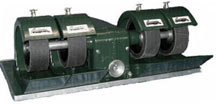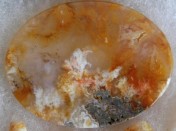About 6 years ago I bought a sanding lapidary unit with expandable

wheel drums. I got the equipment from an old rockhound along with a wealth of information. He had been cutting and collecting rough for 60+ years and was retiring. He made all his own cabochons for shows and devised a sanding system that would get him a finished stone with a glassy polish quick! He was very gracious to share his knowledge and the love of the lapidary hobby. I spent over 3 hours with him as he showed me how quick his system was for turning out lots of cabochons. So he shared and I was a sponge.

The following is the unique system.
I use the poly cotton crystallite 8x3-inch belts. Any manufacturer that has these size belts will work. They run anywhere from $4 to $6.50 each, and generally come 3 to a box. I use the kind that are not charged - this means there is no grit/diamond on them. These belts last a long while.
I mix my own diamond paste according to the following procedure: I purchase
 diamond powder in 5 ct vials each of 100, 360, 600 and 1200 mesh. I combine each vial with 20 grams of vaseline in an old medication bottle or film canister using a popsicle stick to thoroughly mix it up. I make sure to mark the mesh size on each lid. I purchased a small pocket scale to measure my vaseline the first time, because I
diamond powder in 5 ct vials each of 100, 360, 600 and 1200 mesh. I combine each vial with 20 grams of vaseline in an old medication bottle or film canister using a popsicle stick to thoroughly mix it up. I make sure to mark the mesh size on each lid. I purchased a small pocket scale to measure my vaseline the first time, because I
 had no idea how much 20 grams was. Now, I don't measure, but just know that a 20 gram ball of vaseline is about the size of a walnut. Besides, it is not imperative to be exact because this recipe is very concentrated, goes along way and will therefore last a long time.
had no idea how much 20 grams was. Now, I don't measure, but just know that a 20 gram ball of vaseline is about the size of a walnut. Besides, it is not imperative to be exact because this recipe is very concentrated, goes along way and will therefore last a long time.
I use 4 expandable drums, one for each size mesh on 2
 different arbors. I use mineral from a spray bottle as a coolant for each belt. I spray each new belt with the minerals oil until they are coated - 4 or 5 good squirts will do. (the belts will get darker as they absorb the oil). I
then use my finger to wipe the diamond/vaseline paste on each belt while it
different arbors. I use mineral from a spray bottle as a coolant for each belt. I spray each new belt with the minerals oil until they are coated - 4 or 5 good squirts will do. (the belts will get darker as they absorb the oil). I
then use my finger to wipe the diamond/vaseline paste on each belt while it
 goes around. Only a little bit is necessary - about the size of a pea since a
little diamond goes a long way. The Vaseline is a means to hold the diamond powder and is easy to apply. The slurry is mostly made by the mineral oil. I trim and grind with water, but sand with mineral oil.
goes around. Only a little bit is necessary - about the size of a pea since a
little diamond goes a long way. The Vaseline is a means to hold the diamond powder and is easy to apply. The slurry is mostly made by the mineral oil. I trim and grind with water, but sand with mineral oil.
While I'm sanding, I will hear a shoo-shing sound. I don't
know a better way to describe the sound to others, but all I can tell is that you'll know it when you hear it. This is the diamond at work. Whenever
I feel the stone getting warm, I spray a little oil across the belt. I will only add more paste when I no longer hear the shoo-shing sound. I sand a few dozen stones before I will have to add another pea size amount. With softer stones, I will get more than that sanded. I repeat this process until I have the stone completely sanded.
The most critical thing is not to contaminate the wheels. When I'm done with a wheel, I make sure that you use a tooth brush and dish soap and wash the stone, dop stick, and my fingers before moving on to the next wheel/mesh size.
I have learned that if If I don't wash between each step, I will fight with scratches throughout the entire process. Also, an old retired rockhound once
 told me, "When you think your done sanding, sand for 10 more minutes. The better the sanding job, the better the polish."
told me, "When you think your done sanding, sand for 10 more minutes. The better the sanding job, the better the polish."
Anyway, this is the method I use and it's fast. I can cut a stone/cab from
start to finish in 22 mins. Here I am 6 years later having cut almost 1300 cabs a year for the last couple years. I collect in the spring and summer, and cut and polish through the winter - being in Wisconsin there is not much else to do on the frozen tundra.
Click logo below to return to HomePage
